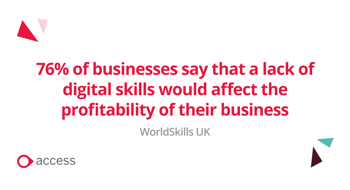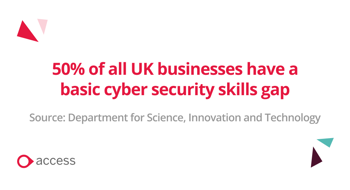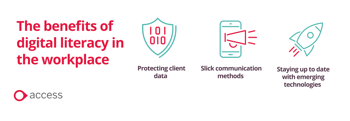Exploring the digital skills gap: Why you should be investing in digital upskilling
The role technology continues to play in the business landscape is constantly evolving. Digital tools should be utilised to ensure they work well for the business, but for organisations to keep up, they must adjust their approach to digital skills. Without the right training and development opportunities, employees will not be able to bridge this gap successfully.
In this article, we will be discussing the digital skills gap in 2024, asking "what is digital literacy"? and exploring how to successfully implement a digital upskilling programme.
- Exploring the digital skills gap in 2024
- The Digital Skills shortage in the UK in 2024
- What is Digital Literacy?
- What are the benefits of digital literacy in the workplace?
- How to improve digital literacy in the workplace
- How to use soft skills as part of your digital upskilling program
- Digital skills gap: Upskilling and reskilling.
- Closing the digital skills gap – final thoughts
Exploring the digital skills gap in 2024
Last year saw a dynamic shift in how technology is embraced by organisations across the globe. Artificial Intelligence (AI) models are now readily used to create more efficient ways of working, and this has received mixed feedback. According to PwC’s 2023 report, 31% of respondents believe AI will help them increase their productivity/efficiency at work, suggesting that some are willing to adapt to the opportunities AI can bring.
However, there are a lot of unknowns that AI automation brings, with over two-thirds of UK marketers fearing generative AI will create content that is biased, plagiarised or misaligned with their brand’s values. There is also a worry that AI will replace jobs, with many reporting on this ongoing concern. This pinpoints the balance that needs to be struck when looking at implementing AI measures – it must be used carefully and with a human approach.
There are other factors that should be looked at when exploring the digital skills gap in 2024 too. With many people working from home and a lot of meetings being carried out remotely with people across the globe, there is a heightened cyber security risk which organisations need to be aware of and be prepared to deal with.
With 76% of businesses saying that a lack of digital skills would affect the profitability of their business, digital literacy is something all organisations must get to grips with in order to succeed. However, this can’t be done in a silo; it is the responsibility of leaders to introduce and support digital upskilling and reskilling initiatives to ensure any skills gaps are filled.

The Digital Skills shortage in the UK in 2024
According to Forbes, 93% of UK businesses say there is an IT skills gap which is a truly alarming statistic. In a time when technology is developing at a rapid rate and isn’t slowing down, numbers like these can’t be ignored. Let’s look at some factors which could be influencing these statistics.
Adopting new practices
A successful modern workforce is made up of many different people from all walks of life, and while this brings different dynamics to a company, it does also have its drawbacks. Some people are less keen to adopt new practices and feel worried about embracing different ways of working, which can directly impact digital literacy. Whilst this is not limited to a certain group of people, some workers are often less technically-savvy than Gen Z who grew up with the internet at their fingertips. The resulting digital skills shortage in the UK highlights the need for comprehensive strategies to bridge this gap and ensure a digitally proficient workforce across all age groups and competencies.
Digital literacy in a remote working environment
Whilst the days are Covid are behind us, a change has been felt since then, with an ONS study finding that 44% of workers reported home or hybrid working. Long gone are the days of walking over to a desk to have a conversation – now meetings are held over Microsoft Teams and shared documents are used to brainstorm ideas. If workers aren’t keeping up with these changes and feeling confident in how to use the appropriate tools, then the skills gap will only expand further.
Talent shortages in data science and cyber security
When looking at talent and digital skills shortages in the UK, the topic of data science and cyber security can’t be ignored. With the digital landscape progressing at such a rapid rate, organisations must be in a position to keep up – and reports are showing this is not the case, as 50% of all UK businesses have a basic cyber security skills gap. The continuation of AI automation and the fears surrounding it, as highlighted above, suggest that the problem is not an easy fix.


Discover the power of ROI in Learning and Development. Our ultimate guide provides you with all the information you need to drive your business forward.
What is digital literacy?
Digital literacy refers to a person’s ability to successfully use and understand digital technologies and digital literacy skills.
This requires the skills to navigate, evaluate, and create information using digital devices and platforms. Being digitally literate is not just about using digital technology, it also requires a fundamental understanding of the benefits of digital literacy in the workplace and how it can be used responsibly.
From an organisational perspective, being digitally illiterate can have consequences that are not easy to rectify. Below are some negative effects a lack of digital literacy can have:
- Inefficient use of digital tools and applications can lead to slower processes and a reduction in productivity.
- Lack of awareness about online security practices may expose the business to cyber threats, such as phishing attacks and data breaches.
- Digital illiteracy can contribute to the persistence of outdated business practices, meaning the adoption of more efficient and modern workflows is reduced.
- A lack of digital support may put a company at a competitive disadvantage compared to more tech-savvy competitors.
What are the benefits of digital literacy in the workplace?
When an organisation works towards creating a digitally literate workforce, it has a huge impact on business efficiencies. Creating and supporting a workforce that is adaptive to change will lead to a more successful business model. Let’s explore some benefits of digital literacy in the workplace and the ways in which they can positively impact an organisation from the top down.
Protecting client data
Did you know the average annual cost of cybersecurity breaches for mid-to-large UK businesses currently totals £8,040? This shows that the topic isn’t something that should be ignored or brushed over – it isn’t going away and it’s a fundamental part of living in the digital age. Therefore, it’s imperative that a workforce understands how to use technology in a safe and secure manner, especially if dealing with sensitive data, such as those in IT. However, it expands further than this area, as everyone within an organisation needs to understand how cyber awareness training defends your business against cyber attacks.
Slick communication methods
In a world where computers are now commonplace, everyone needs to be comfortable with different methods of communication no matter what the job role is. To help close the digital skills gap, employees must be given training on how to effectively and efficiently utilise communication tools within digital software both for internal use and when dealing with external parties.
Staying up to date with emerging technologies
Forbes recently reported the top factor contributing to the IT skills shortage in the UK and its effects on job market is ‘rapid technological advancements’. By embracing digital-first strategies, companies can adapt more quickly to changing market conditions, innovate more effectively, and stay competitive which will in turn help close the digital skills gap.

How to improve digital literacy in the workplace
Six tips to help employees close their digital skills gaps.
How to use soft skills as part of your digital upskilling program
Creating a digital upskilling programme to keep your workforce up to date with technological advancements is crucial. While having the right training and tools to hand will help to stay abreast of digital updates, there are also important soft skills that should be encouraged as part of a digital upskilling strategy, such as:
- Adaptability allows professionals to navigate changes and embrace innovation seamlessly
- Communication is essential for ideas sharing, collaborating with different teams and discussing new concepts in a digital world
- Problem-solving empowers individuals to approach digital challenges with resilience and a mindset of growth
These transferable skills will encourage continuous learning and ensure that professionals acquire new digital competencies with ease whilst thriving in dynamic work environments.
Digital skills: Upskilling and reskilling
When looking at enhancing the digital skills within your organisation, it’s important to consider both upskilling and reskilling initiatives. Upskilling ensures that employees stay up to date with the latest advancements in their respective fields, fostering a workforce that is adaptable to changing industry demands. Reskilling, on the other hand, addresses the need for a more profound transformation, often in response to emerging technologies or shifts in job requirements.
Our self-directed learning platform - powered by Bookboon - offers a large library of digital upskilling courses on topics such as AI and digital literacy which can help your workforce feel more confident using these tools as part of their day-to-day job roles.
Consider the following digital upskilling courses when looking at upskilling and reskilling your workforce:
We also offer Cyber Security Awareness training which provides users with the up-to-date knowledge and information they need to be able to navigate the world of cybersecurity.

Did you know 39% of UK businesses were the victim of a cyber attack in the last 12 months?
Closing the digital skills gap – final thoughts
As we have discussed within this article, the changing digital landscape of the UK demands a proactive approach from organisations. Recognising the benefits of digital literacy, from protecting client data to keeping your business up to date with technological changes and staying adaptable at work, underscores the urgency to invest in comprehensive digital upskilling courses.
Alongside this, organisations must embrace a continuous learning culture to navigate the digital age successfully and leverage resources like self-directed learning platforms for tailored courses, ensuring a workforce well-equipped to thrive in the digital age.
Start closing your digital skills gap today!
There are many ways to find out more about Access Learning and how it can transform learning, development and compliance in your business.
Speak to an expert
Chat with one of our learning experts and find out why Self Directed Learning has usage rates four times higher than any other digital learning solution.
Schedule a live demo
Chat with one of our learning experts and find out how Access Learning can be tailored to meet the needs of your business, regardless of size.
Get cyber resilient
Our Cyber Awareness eLearning catalogue includes essential training to make your employees your first line of defense against cyber crime.

